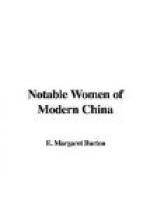In 1892, Maiyue and her friend, Ida Kahn, accompanied Miss Howe to America, there to receive the medical education for which they had long been preparing. If America held much that was new and interesting to them, it was no less true that they were something new and very interesting to America. “What makes these girls look so different from the other Chinese women who come here?” the Government official who examined their passports asked Miss Howe. “All the difference between a heathen and a Christian,” was her prompt response.
That there were Chinese girls who could successfully pass the entrance examinations to the medical department of the University of Michigan, in arithmetic, algebra, rhetoric, general and United States history, physics, and Latin, was a revelation to the people of America, and their college career was watched with the greatest interest.
While in Ann Arbor, Maiyue took pity on the professors who found it so difficult to pronounce her Chinese name, and decided to use the English translation of it, Mary Stone, during her stay in America. Accordingly one morning when the professor started to call on her, she announced, “I have decided to change my name, professor.” The burst of laughter with which the class greeted this simple statement was most bewildering to her; but after she had seen the joke she often declared that she was “one of the products of Christianity, an old maid,” for, as she pointed out, an unmarried woman is practically unknown among non-Christians.
During her medical course Mary became more strongly impressed than ever before with the evils of foot-binding. Her mother’s feet had, of course, been bound in childhood, and although Mrs. Stone had never bound the feet of any of her daughters, she had not unbandaged her own. For she said that if she also had unbound feet people would say: “Oh, yes, she must be from some out-of-the-way place where the women do not bind their feet, and so she does not know how to bind the feet of her daughters. That accounts for such gross neglect.” On the other hand, she reasoned that if she herself had the aristocratic “golden lily” feet, it would be evident that her failure to bind her daughters’ feet was due to principle. But while Mary was pursuing her medical studies she became convinced that the time had come when her mother ought to register a further protest against the harmful custom, by unbandaging her own feet, and wrote urging her to do so. Mrs. Stone readily agreed to this. Moreover, at the annual meeting of the Central China Mission in 1894, when a large mass-meeting was held for the discussion of foot-binding, she ascended the platform and in a clear voice, which made every word distinctly heard to the remotest corner of the large chapel hall, told why she had never before unbound her feet, and why she was now about to do so. Her husband was so in sympathy with her decision that later in the meeting he added a few words of approval of the course she had taken. The last shoes worn before the unbinding, and the first after it, were sent to Ann Arbor to the daughter who had so long been a living exponent of the doctrine of natural feet.




